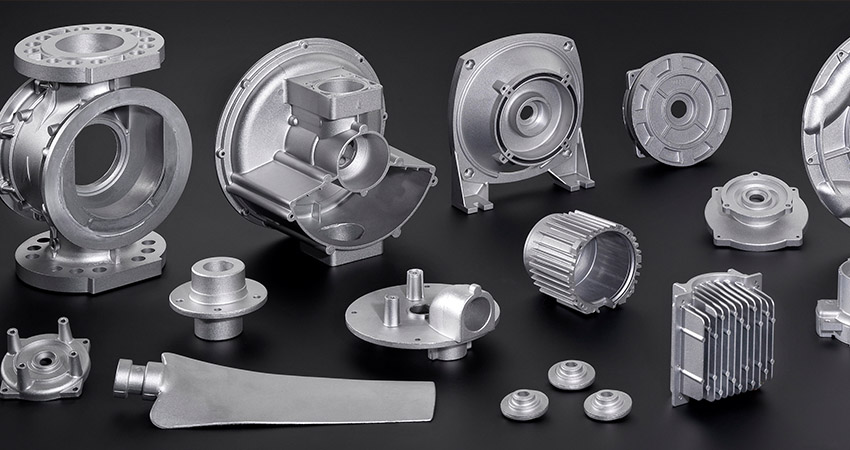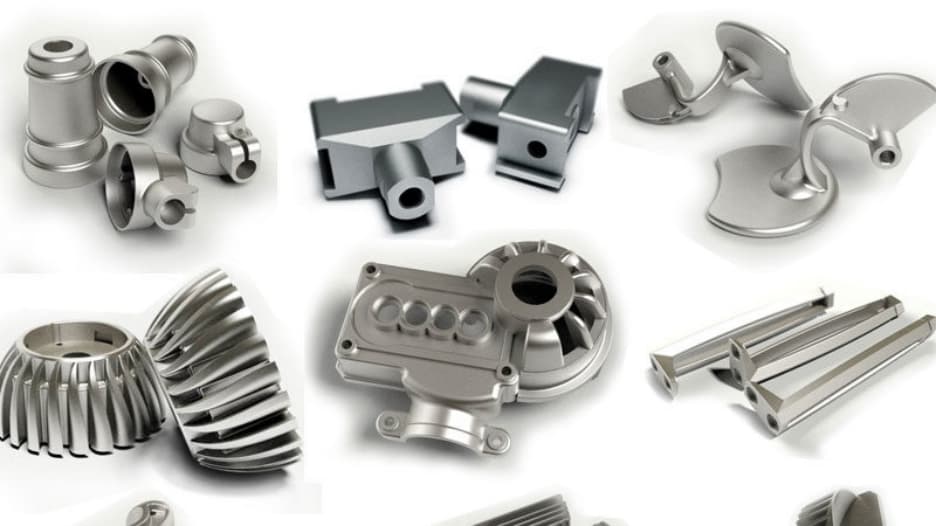Aluminum Casting for gadgets: Why it’s critical for innovation
A Comprehensive Overview to the Different Kinds and Applications of Aluminum Castings
Aluminum castings are vital elements in various industries, understood for their lightweight and resilient residential properties. Various casting methods, such as sand, pass away, and investment casting, offer distinctive advantages tailored to particular applications. Comprehending these processes is essential for choosing the right approach for a task. Each technique has its distinct advantages, influencing design and production choices. The expedition of these methods discloses a deeper insight into their effect on contemporary production.
Review of Aluminum Castings
Aluminum castings are essential elements in various industries, known for their lightweight and corrosion-resistant properties. These castings are produced via processes that permit intricate designs and high dimensional precision. The flexibility of aluminum makes it an excellent selection for a series of applications, from vehicle parts to consumer electronics. As a result of its superb thermal and electrical conductivity, aluminum is likewise favored in electrical real estates and heat sinks. In addition, aluminum castings can be treated with different surface coatings, boosting their aesthetic allure and longevity. The material's recyclability includes in its sustainability qualifications, making it an eco friendly choice. Additionally, the schedule of various aluminum alloys enables suppliers to tailor the mechanical buildings to details requirements, offering boosted strength or boosted resistance to use. Generally, aluminum castings play a considerable function in modern production, contributing to the performance and efficiency of many products throughout varied fields.
Sand Casting: Process and Applications
While numerous casting methods exist, sand casting remains among one of the most widely made use of strategies because of its simplicity and adaptability. This process includes developing a mold and mildew from a mix of sand and a binding representative, enabling the production of intricate forms with high dimensional accuracy. The aluminum is melted and poured right into the mold and mildew, where it takes the desired type as it cools and solidifies.
Sand casting is specifically efficient for creating large components and low to tool volume runs, making it appropriate for various industries, including auto, aerospace, and customer items. Its versatility enables for the casting of complex layouts, suiting varied specifications. Furthermore, sand mold and mildews can be reused several times, boosting cost-effectiveness. The convenience of sourcing materials and the fairly reduced arrangement expenses even more contribute to its prevalent fostering. On the whole, sand casting plays a pivotal function in the aluminum casting landscape, fostering development and effectiveness.
Die Casting: Benefits and Uses
Die casting deals numerous benefits that make it a recommended approach for generating aluminum components in various industries. This procedure allows for high-volume production with remarkable dimensional accuracy and surface area coating. The quick solidification of aluminum throughout die casting causes a solid and durable item, lessening the demand for considerable machining or finishing procedures.
Furthermore, pass away casting allows the production of intricate shapes and elaborate designs, which can be testing to attain with various other casting approaches. The reliable usage of products decreases waste, making it a cost-efficient solution for producers.
Applications of die casting span various sectors, consisting of auto, aerospace, and consumer electronics, where light-weight and high-strength parts are vital. Overall, pass away casting sticks out for its capacity to provide quality, effectiveness, and versatility in aluminum element manufacturing, solidifying its function in modern-day manufacturing techniques.
Financial Investment Casting: Precision and Information
Financial investment casting is an accuracy production process that enables intricate designs and in-depth features in aluminum parts (Aluminum Casting). This approach supplies various advantages, including high dimensional precision and a smooth surface area coating. Its flexibility makes it relevant throughout different sectors, from aerospace to clinical gadgets
Process Review
The investment casting process attracts attention for its ability to create intricate aluminum parts with exceptional precision and information. This method begins with developing a wax or polymer pattern that is a reproduction of the preferred component. Next, the pattern is coated with a ceramic covering, which is after that warmed to solidify. As soon as the shell is set, the wax is thawed away, leaving a tooth cavity in the covering. Liquid aluminum is poured right into this tooth cavity, filling it to create the last part. After cooling, the ceramic shell is broken away, disclosing the cast component. This procedure enables intricate geometries and fine surface coatings, making it ideal for numerous applications, from aerospace to auto sectors.
Advantages of Investment Casting
Among the key benefits of investment casting hinges on its ability to supply high-precision elements with elaborate information. This approach enables for the development of intricate geometries that are typically unattainable via various other casting strategies. Financial investment casting decreases the requirement for substantial machining, decreasing material waste and production time. Additionally, it makes it possible for the usage of different aluminum alloys, improving the flexibility of the end product. The process is defined by a smooth surface area coating, which can bring about improved capability and appearances. Financial investment casting is appropriate for both tiny and big production runs, fitting a vast array of markets. Overall, its accuracy and effectiveness make investment casting a recommended choice for manufacturing parts needing exact requirements.
Applications in Sector
While different casting methods serve specific objectives, financial investment casting stands out for its extensive applications throughout several industries because of its unequaled accuracy and information. This method is specifically favored in aerospace and vehicle industries, where intricate elements require precise specs for safety and performance. Investment casting enables the manufacturing of complex shapes, such as turbine blades and engine parts, that typical methods can not attain. In addition, clinical gadget manufacturers use investment casting for producing very detailed tools and implants, guaranteeing biocompatibility and functionality. The electrical and electronics sectors additionally benefit, creating parts like housings and ports that demand great tolerances. In general, financial investment casting's versatility and precision make it a necessary procedure in contemporary manufacturing throughout varied fields.
Comparison of Casting Techniques

Sand Casting Advantages
Sand casting uses several advantages over various other casting techniques, especially when it involves versatility and cost-effectiveness. This strategy enables the manufacturing of complicated forms and large components without the requirement for pricey tooling. In addition, the sand used in this process is easily available and inexpensive, making it an attractive alternative for both little and large manufacturing runs. The ability to reuse sand promotes sustainability and lowers material expenses. Sand casting fits a selection of aluminum alloys, improving its versatility for various applications. The procedure is additionally reasonably basic, which contributes to much shorter preparations and versatility in production. These elements make sand casting a preferred choice for lots of industries looking for reliable and cost-effective services.
Die Casting Performance
Although various casting approaches are readily available, pass away casting stands apart for its effectiveness, specifically Continue in high-volume manufacturing situations. This technique employs high-pressure pressures to infuse liquified aluminum right into a mold, leading to rapid cycle times and constant product high quality. Contrasted to sand casting and financial investment casting, die casting significantly minimizes product waste and allows for complex designs with limited tolerances. The capability to generate huge quantities of components promptly makes it ideal for sectors such as automobile and durable goods. In addition, die casting can assist in making use of more economical alloys, further enhancing its cost-effectiveness. Overall, the performance of die casting makes it a recommended selection for makers aiming to enhance both manufacturing speed and quality.
Investment Casting Accuracy
Financial investment casting is commonly identified for its outstanding precision in producing intricate shapes and intricate information. This technique includes developing a wax pattern, which is covered in a ceramic shell, and ultimately melted away, leaving a precise dental caries for molten aluminum. Compared to various other casting approaches, such as sand casting or die casting, investment casting offers tighter resistances and a smoother surface area coating. This precision makes it excellent for applications calling for high precision, such as aerospace and clinical device elements. While the initial setup prices might be greater, the long-lasting advantages consist of decreased machining demands and consistent quality. Financial investment casting stands out as a favored option for intricate layouts and demanding specs in numerous markets.
Sector Applications of Aluminum Castings
Aluminum castings play an essential function across numerous markets due to their lightweight, corrosion-resistant buildings and excellent strength-to-weight ratio. In the automotive sector, aluminum castings are extensively utilized for engine parts, transmission real estates, and structural components, adding to fuel performance and performance. The aerospace industry advantages from aluminum castings in aircraft frameworks, engine places, and interior fittings, where weight reduction is critical.
Additionally, the consumer electronic devices industry makes use of aluminum castings for enclosures and elements, boosting sturdiness while maintaining a smooth visual. In the building industry, aluminum castings are used in architectural aspects, home window structures, and architectural assistances, supplying resilience against weathering. Additionally, the aquatic industry prefers aluminum castings for boat hulls and installations due to their resistance to deep sea corrosion. Overall, aluminum castings provide functional options, fulfilling varied needs across numerous applications while keeping high efficiency and integrity.

Future Patterns in Aluminum Casting Innovation
As industries remain to develop, developments in aluminum casting innovation official site are positioned to improve producing processes and product design. Arising patterns consist of the assimilation of automation and man-made intelligence, enhancing production and enhancing quality assurance. 3D printing is additionally acquiring traction, allowing for extra complex geometries and lowered waste, thereby promoting sustainability. Additionally, the advancement of high-performance alloys is expanding the applications of aluminum castings, allowing industries to satisfy strenuous efficiency standards.
Another substantial pattern is the enhancing concentrate on recycling and the round economic climate, with advancements aimed at recycling aluminum scrap successfully. Industry players are likewise purchasing smart manufacturing methods, incorporating IoT for real-time monitoring and predictive upkeep. Developments in surface area therapy technologies are improving the toughness and visual charm of aluminum castings. Collectively, these patterns represent a transformative duration in aluminum casting, driving effectiveness, sustainability, and innovation across different sectors.
Frequently Asked Concerns
What Are the Environmental Impacts of Aluminum Casting Processes?
The environmental influences of aluminum casting processes consist of greenhouse gas emissions, power intake, and waste generation. These variables add to air and water air pollution, prompting the demand for sustainable techniques and boosted resource management in the sector.
How Can Aluminum Castings Be Recycled Efficiently?
Efficient recycling of aluminum castings includes gathering scrap, getting rid of pollutants, and melting the aluminum to produce new castings. This process preserves energy, minimizes waste, and minimizes ecological effects, promoting a much more lasting manufacturing cycle.
What Is the Common Life Expectancy of Aluminum Castings?
The regular life expectancy of aluminum castings differs significantly, typically long-term in between 20 to half a century depending on ecological aspects, alloy structure, and application. Their sturdiness makes them suitable for various demanding industrial and architectural usages.
Are There Any Kind Of Health Threats Related To Aluminum Casting?
Issues regarding wellness threats related to aluminum casting consist of prospective exposure to fumes and dust. Extended breathing may result in respiratory system issues, while skin call can trigger irritability. Proper precaution are important to mitigate these risks.
Just How Do Aluminum Castings Compare to Other Products in Stamina?
Aluminum castings show a favorable strength-to-weight ratio contrasted to lots of materials, consisting of steel and plastics (Aluminum Casting). They are lightweight yet solid, making them perfect for applications needing toughness without extreme weight, such as automobile and aerospace parts